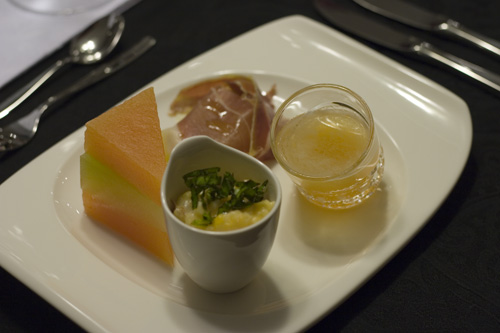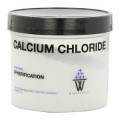This recipe is adapted from Modernist Cuisine and is one I use as part of a Ham and Melon tasting I created to celebrate the diversity of summer melons. This recipe uses the basic spherification method to make brightly colored melon caviar and float atop the ham broth giving it the appearance of a sparkling wine.
If this isn’t enough complexity for you, check out the epic dinner party this dish was featured in.

Ingredients:
Ham Broth
- 500g Cold Water
- 250g Serrano Ham sliced thinly
- 0.6g Xanthan Gum
Melon Caviar
- 500g Cantaloupe Juice (from about 800g Melon)
- 2g Sodium Alginate
- 500g Water
- 2.5g Calcium Chloride
Preparation – Ham Broth
- Combine the Ham and Water in a pot and simmer for 15 minutes.

- Strain the broth through a sieve lined with cheesecloth and discard the ham.
- Chill the broth over an ice bath and then refrigerate until the fat floats to the surface and hardens. Remove and discard the fat.

- Blend the xantham gum into the ham broth and refrigerate for several hours to allow the air to escape. Alternatively you can use a chamber vacuum sealer to remove the air.
Preparation – Melon Juice
- In a high sided container, blend the Melon juice with the sodium alginate for several minutes to ensure it is thoroughly incorporated.
- Leave the Melon juice in the refrigerator overnight so that all the oxygen escapes. Alternatively you can use a chamber vacuum sealer to remove the air.

- In a circular dish, stir the calcium chloride into the water until fully dissolved. Fill another circular dish with room temperature water.
Preparation – Melon Caviar
There are two methods for making the melon caviar. One requires a normal squeeze bottle or food grade syringe. The other requires a pipetting device normally used in scientific laboratories. The squeeze bottle is simpler to use but more time consuming as you are forced to make one drop at a time. The pipetting device produces hundreds of drops in minutes, but requires a bit more effort and technique.
If using the squeeze bottle:
- Fill it with the melon juice and alginate mixture and slowly squeeze out drops into the water and calcium chloride bath.
- Let them rest for 2 minutes then remove them with a small strainer and rinse them for a minute in the fresh water. I like to use a powdered sugar duster for this.
If using the pipetting device:
- You’ll need a pipetting device and a food syringe
- Pour the melon juice into the pipetting tray
-

Place the pipette onto the dish. Insert the syringe into the tube and draw the syringe out to force the juice into the device.

- Lift the device over the calcium chloride and water solution and gently shake up and down. Droplets will fall from the device into the water and begin curing.
- You may need to tilt the device upside down and then back again to get the remaining juice into the release holes.

- Let them cure in the water and calcium chloride bath for 2 minutes then remove them with a small strainer and rinse them for a minute in the fresh water. I like to use a powdered sugar duster for this.
- Repeat this as many times as necessary to get the required number of caviar beads.

To Assemble
- Pour the ham broth into individual clear glasses
- Spoon the caviar beads into the glasses and stir to disperse them
- Serve immediately as the melon beads will continue curing and eventually become solid




Leave a Reply